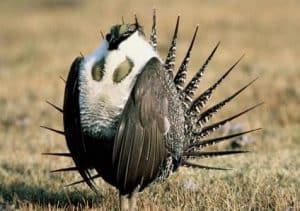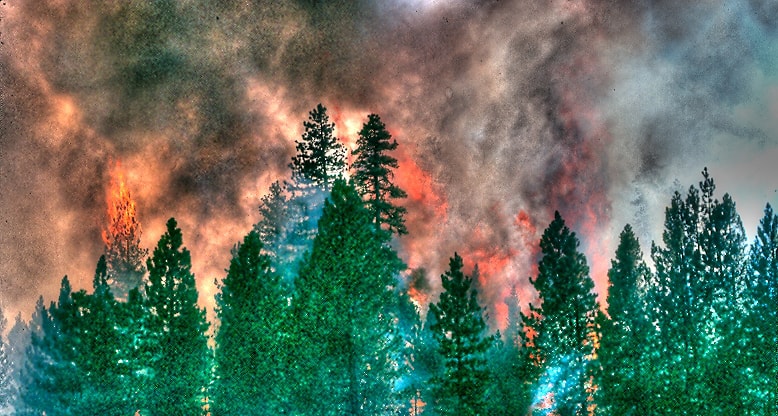Time is running out to comment on the notice that initiated “the scoping process to solicit public comments on greater sage-grouse land management issues that could warrant land management plan amendments” on 15 national forests and grasslands. (Comments are due Friday.) The majority of sage grouse habitat is found on BLM lands (I think the Forest Service has 8%) and the Forest Service is following behind the Department of Interior’s lead to “consider” rolling back restrictions, especially those that interfere with oil and gas drilling. Those restrictions were added to Forest Service and BLM plans in amendments that were adopted in 2015 pursuant to the 1982 planning regulations for species viability, and have been credited with avoiding the need to list sage grouse as threatened or endangered. The Forest Service concedes that amendments it would propose would be likely to be “directly related” to, and therefore subject to, the new diversity and viability requirements of the 2012 Planning Rule. More background from the Forest Service here.
Landscape Scale
Forest Service to revise NEPA procedures
The Forest Service is proposing to revise its NEPA procedures (including its regulations at 36 CFR part 220, Forest Service Manual 1950, and Forest Service Handbook 1909.15) with the goal of increasing efficiency of environmental analysis. The Forest Service’s NEPA procedures were last reviewed in 2008 when the Agency moved a subset of its NEPA procedures from the Forest Service Manual and Handbook to the Code of Federal Regulations. However, the Agency’s NEPA procedures still reflect in part the policies and practices established by the Agency’s 1992 NEPA Manual and Handbook.
The Agency is seeking public comment on the following:
- Processes and analysis requirements that can be modified, reduced, or eliminated in order to reduce time and cost while maintaining science-based, high-quality analysis; public involvement; and honoring agency stewardship responsibilities.
- Approaches to landscape-scale analysis and decision making under NEPA that facilitate restoration of National Forest System lands.
- Ways the Agency might expand and enhance coordination of environmental review and authorization decisions with other Federal agencies, as well as State, Tribal, or local environmental reviews.
Bigger projects, more categorical exclusions, shorter timelines, but “The Agency will continue to hold true to its commitment to deliver scientifically based, high-quality analysis to decision makers that honors its environmental stewardship responsibilities while maintaining robust public participation.”
Review of collaborative restoration initiatives
The Forest Service funded a study (2 page summary here) of the Collaborative Forest Landscape Restoration Program and the Joint Chiefs Landscape Restoration Partnership. Of note (to me any way):
Findings: “Strong majorities said they had increased the pace and scale of restoration, improved ecological conditions, and reduced the threat of fire to communities.” “61% said they had decreased litigation.”
Implications: “The agencies should continue to make changes to their business model to ensure that their organizations are oriented towards the success of priority projects. The agencies should ensure quality leaders and staff capacity follow priority investments. The agencies also could refine proposal evaluation processes to better identify places likely to be successful, or those that are in need of support and capacity building.”
(I assume that the project “priorities” are a result of collaboration, too.)
What is Beyond the “Fog of War”?
There are scary and uncertain times ahead for our forests. There is just too much “Fog of War” going on for the public to sort out and fact-check for themselves. Even the ‘fact-checkers’ should be suspect, until proven reliable and bias-free. The rise of ‘fake news’ has blurred multiple lines, and many people, even in mass media, fall for the hoaxes, satire or misinformation. (Example: An article appeared on the Grist website, showing concern about a recall of “Dog Condoms”, presenting the link to www.dogcondoms.com )
Forest Service wins A to Z
The Ninth Circuit affirmed the district court denial of a preliminary injunction for the North Fork Mill Creek A to Z Project on the Colville National Forest, which has been discussed here. Of note, the question of contractor-NEPA was not addressed, although the court said that the Forest Service “reviewed and approved” the EA, and “The Forest Service subsequently retracted and revised the EA to address concerns raised by the public.”
That’s right, an EA on a 13,000 acre logging project with some at-risk species. How could that be? The short answer is essentially full mitigation of effects. For pine marten and fisher, the plaintiffs agreed that goals in the forest plan would protect the habitat, and that the project was consistent with those goals by correctly identifying the habitat and leaving it alone. The legal arguments they made were more technical and weaker. So, while there are some differences here from the Colorado Tennessee project in lynx habitat, it appears that the Colville forest-wide conservation strategy for these species also simplified the project NEPA process. Full mitigation basically also occurred for sediment and open road density (It also probably didn’t hurt that, “The project was the result of a multi-year collaboration among elected officials, environmental organizations, Native American tribes, the timber industry, and community organizations.” And maybe that had something to do with why the FS agreed to this degree of mitigation.)
The opinion includes an interpretation of the 2012 Planning Rule’s requirement for the use of the “best available scientific information in the forest planning process” (despite the fact that the new Planning Rule does not apply to either the existing plan or to any projects). Quoting a Ninth Circuit case: A party challenging the Forest Service’s scientific analysis cannot simply “cite studies that support a conclusion different from the one the Forest Service reached” and must instead provide “scientific studies that indicate the Forest Service’s analysis is outdated or flawed.”
Early seral wildlife species driving forest planning debate in the southeast
Here’s an in-depth article on the ongoing revision of the plan for the Nantahala-Pisgah National Forest in North Carolina, featuring the extent to which the Forest should provide early seral habitat (ESH).
Many conservation advocates disagree over whether promoting this specific sort of habitat over others is desirable on a large scale. They also question whether aggressive advocacy for ESH stems more from a desire to conserve species or to boost game numbers and accessibility for the benefit of sportsmen.
Fish and Wildlife Conservation Council:
The FWCC is a proponent of expanding active wildlife habitat management and restoration through, among other things, more timber harvesting and controlled fires. Central to their advocacy is forest restoration and increasing the amount of early successional habitat across the landscape, including grasses, shrubs and trees that provide food, cover and habitat for wildlife. The FWCC believes that the future management of the National Forest should target a minimum of 12 percent of forest in an age class of 0-12 years. The need to improve game populations is a central argument of the FWCC and has been cited as a reason to oppose new additions to the wilderness base in several county resolutions.
The Nature Conservancy:
Warwick of TNC said that historically speaking there’s strong evidence that there was a much greater distribution of young forest and more grassy areas across the landscape prior to the 20th century. However, fire suppression has been a primary factor in abetting forest growth that is now lacking in young forest age classes and creating a canopy that is too dense. “Most of the species that are declining in the Southern Appalachian require ESH somewhere in their life cycle,” he said. “If we decide it is important to stem their decline, then there’s no (other) choice than to take an active management role. That means more fire and timber harvesting.”
Southern Environmental Law Center:
Sam Evans, an attorney with the Southern Environmental Law Center and member of the stakeholders forum agrees that ESH is underrepresented in the forest, especially if you look at those tracts in isolation. Nobody who is actively participating in stakeholder discussions is objecting to increasing habitat diversity, including an increase in harvest for ESH,” said Evans in an email written to CPP. He said that the organizations he works with are “wildlife advocates.” “The truth is, I and other conservation voices are supporting precisely the same goal—restoration of ecological integrity in order to provide needed habitat for all the forest’s native species,” Evans said.
To borrow from the forestry professionals, “ecological integrity is the answer.” According to the interpretation of NFMA in the 2012 Planning Regulations any way. What’s muddied the waters in NC is the idea that wilderness designation is somehow contrary to ecological integrity (it limits tools, but the desired outcome is the same). Not mentioned in the article are which species are or will be vulnerable because of a lack of ESH (this isn’t what the TNC quote said), and it doesn’t really address how the current and expected conditions of private lands should be accounted for. It does point out that old-growth stands are also underrepresented on the Forest.
A conservation plan puts science ahead of politics
This story about the Pima County Arizona conservation planning effort isn’t directly about national forests, though there should have been (and probably was) coordination with the Coronado National Forest. And my point here isn’t about the success of a conservation plan driven by the need to protect at-risk species (arguably an ESA success story). It’s about the role of scientists in the process (Sharon).
“County leaders stated from the outset that their primary goal was to conserve biological diversity through a scientifically defendable process, not to come up with a plan that everybody could agree on,” wrote the late urban planning specialist Judith Layzer in her 2008 book Natural Experiments, which analyzed more than a half-dozen regional land-conservation efforts.
The scientists and county staff discussed the plan in public sessions, but county officials made it clear that their work would not be derailed by complaints from developers and other critics. The scientists established standards for identifying biologically valuable lands and used computer models, observation records and the judgment of local naturalists and recognized experts to come up with a biological preserve map.
In contrast, in other multi-species plans, scientists, politicians, agency staffers, developers and moderate conservationists collectively determined which lands to save, thus bringing political and economic considerations into the science.
Looking back this spring, Huckelberry, a former county transportation chief, says he was simply applying the best practices from his previous job, highway planning, to land conservation. Typically, both a technical committee and a citizens’ committee review big road projects, he says: “The whole purpose of a technical advisory committee is not to play with the numbers, not to slant the analysis. We felt the political side could potentially be used to manipulate the scientific side, and felt that would bias the entire process.”
After the science team created a map of the proposed preserve system, a separate steering committee of 84 people, including developers, environmentalists and neighborhood leaders, haggled over its details. By then, though, the plan’s broad vision was already solidly in place.
Bringing this back to the Forest Service, this is similar to how a team of biologists developed the Lynx Conservation Assessment and Strategy, which was then followed by forest plan amendments that “haggled over the details.” The Forest Service doesn’t like some of things it can’t do, but there haven’t been challenges to the science. The grizzly bear conservation strategies seem to be more like the alternative process, where what the land managers want is infused into the discussions of the science. (The Yellowstone strategy was already voided by a court once because of scientific issues.)
Forest Service and BLM slightly lose sage grouse lawsuit in Nevada
The state of Nevada, nine counties, three mining companies, and a private ranch challenged the adoption of greater sage grouse conservation measures in Forest Service and BLM land management plans. Most of the agency actions were upheld in Western Exploration v. USDI (D. Nevada), including compliance with FLPMA requirements of BLM for multiple use and consistency “to the extent practical” with local plans, and compliance with NFMA. Here’s the court’s language on Forest Service multiple-use:
“Plaintiffs contend that the SFA (mineral) withdrawal zones, travel restrictions on 16 million acres of land, and grazing restrictions violate the multiple-use mandate of NFMA. They also challenge that the FEIS violates multiple-use principles because it closes millions of acres of land to important uses, replaces “no unmitigated loss” with a requirement for “net conservation gain,” and creates uniform lek buffers that are “no-go zones.”
“The Court’s review of whether the Forest Service Plan violates NFMA’s multiple use mandate is necessarily narrow, and it may consider only whether the Forest Service contemplated all relevant factors in making its determination. First, it is unclear to the Court how travel and grazing restrictions manifest the Forest Service’s failure to consider multiple use. To the contrary, the restrictions demonstrate a balance between conservation of greater-sage grouse habitat and sustainable human use of natural resources. Second, the Court fails to see how multiple use mandates that any particular parcel of land be available for any particular use. While Plaintiffs point out certain land closures in the USFS Plan, such as complete exclusion of new solar and wind energy projects (on SFA, PHMA, and GHMA), the Plan does not exclude all possible human uses on those lands. Finally, Plaintiffs fail to demonstrate how the “net conservation gain” and lek buffer zones preclude multiple use or demonstrate a failure on the part of the Forest Service to consider all relevant factors. In fact, the move from “no unmitigated loss” in the DEIS to “net conservation gain” in the FEIS demonstrates that the Forest Service reconsidered whether their initial standard consistently balanced sustainable human use with adequate habitat conservation.”
The court did not uphold compliance with NEPA. Plaintiffs had identified several changes between the draft and final EIS, and the court agreed that, “the designation of 2.8 million acres as Focal Areas in Nevada amounts to a substantial change relevant to environmental concerns, requiring the Agencies to prepare an SEIS. The court focused on the fact that these lands included the town of Eureka, Eureka County’s landfill, power lines, subdivisions of homes, farms with alfalfa fields and irrigation systems, hay barns, and important portions of the Diamond Valley area, and there would be a “spillover” effect from the changes in adjacent federal land management that warranted additional analysis and opportunity to comment. Because of risk of harm to sage grouse, the court did not enjoin the plan amendments pending completion of the new analysis.
We’re All In This Together

Post-Election Thoughts About Our Forests?
With a new Republican President and a Republican-controlled Congress, how will this affect the Forest Service and the BLM?
Regarding the picture: I did some processing with a High Dynamic Range (HDR) program to get this artsy view. It is interesting that it enhanced the flames better than in the original scan, from a Kodachrome slide. I shot this while filling in on an engine, on the Lassen NF, back in 1988.


